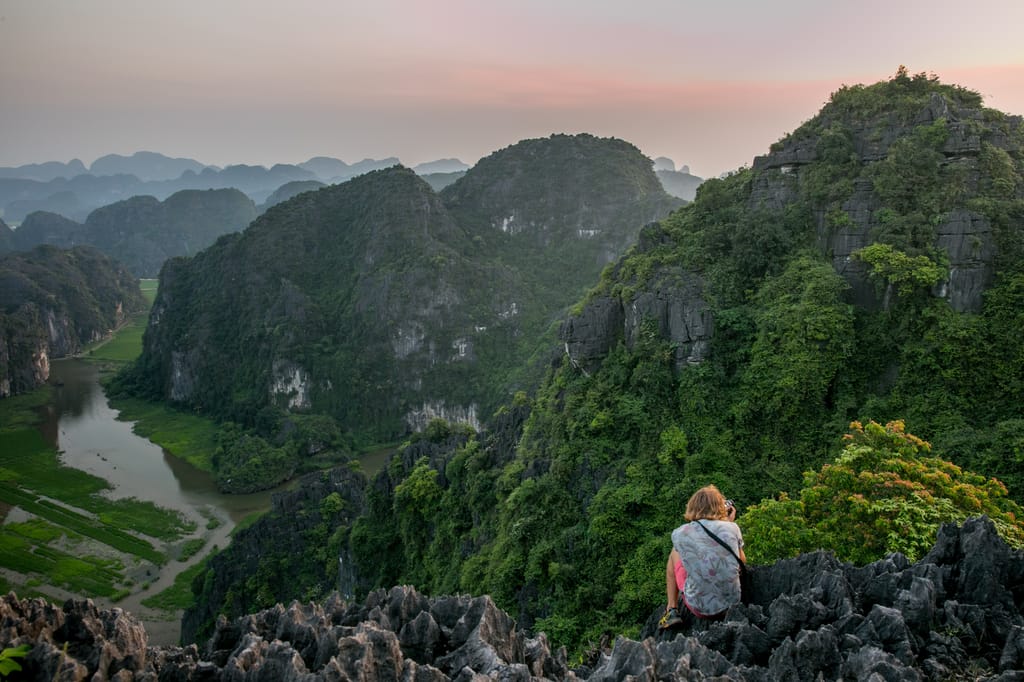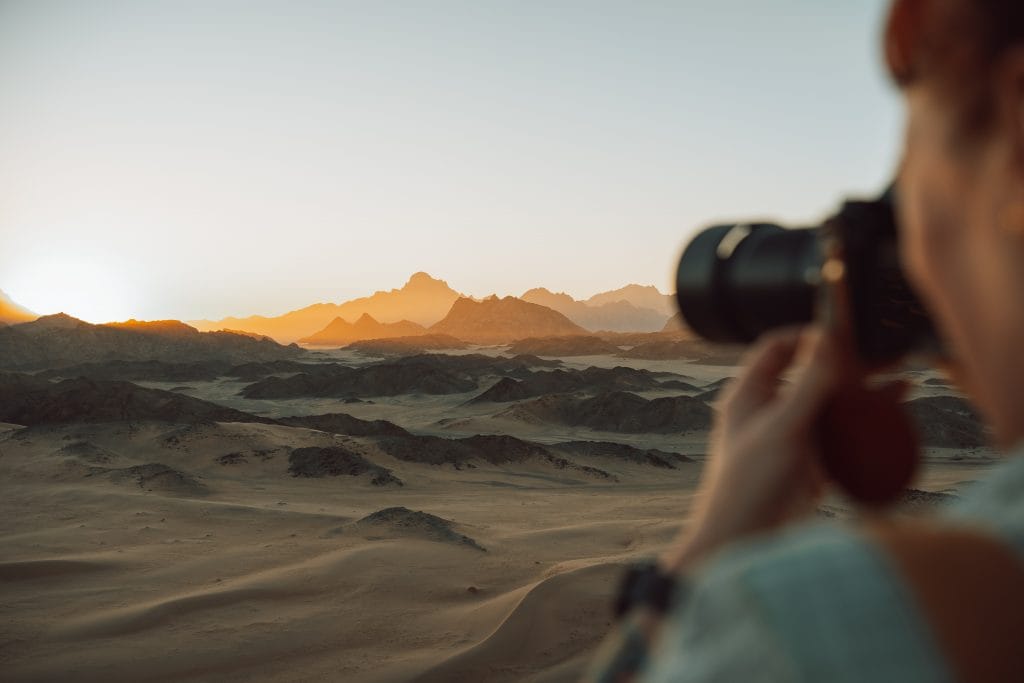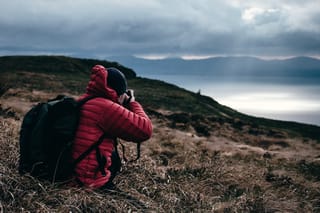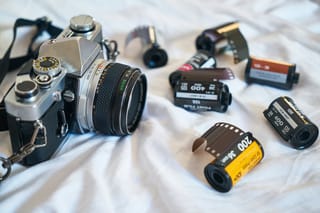
If you crave distant places, new experiences, rich culture, and stunning new landscapes, you might have caught a case of the travel bug! Traveling is an incredible way to expand our understanding and experiences of the world and to create lasting memories. And while memories fade, photographs of our travels can last a lifetime and remind us of the places we’ve been and all the places we have yet to experience.
Travel photography allows you to honor the memories of your journeys in a way that’s unique to you, and it’s for everyone from beginners to seasoned travelers.
In this article, we’ll share our list of tips to help you elevate your adventures and capture beautiful images in a meaningful and memorable way as well as other essential information:
- 16 Travel Photography Tips
- Recommended Travel Photography Gear
- Becoming a Professional Travel Photographer
What is Travel Photography?
Travel photography is the practice of documenting a place’s individual landscape, culture, traditions, history, and people to capture its overall essence. Great photos evoke emotion and transport the viewer to the place without ever having been there. And while your smartphone can take impressive photos of your travels, nothing can replace travel images taken on a high-quality camera.
Types of Travel Photography
Travel photography is an umbrella term for a number of sub genres of photography including:

Landscape photography
Landscape photography focuses on capturing photos of natural scenes or settings, like mountains, the ocean, sky, etc. The primary focus is capturing the beauty of outdoor landscapes.
Street photography
Street photography focuses on capturing everyday moments of life in cities or towns. It generally concentrates on candid photographs that tell a human story.
Wildlife photography
Wildlife photography documents various forms of wildlife in their natural states. It requires a great deal of patience as you may have to wait for hours and sometimes days to capture a sighting of a particular animal.
Architecture photography
This type captures images of buildings and other structures or cityscapes. Many travel destinations are known for their famous historical landmarks or distinct architectural designs.
16 Travel Photography Tips
Now we’ll dive into our comprehensive list of tips and tricks to help you become the best travel photographer you can.

1. Time of day matters
One of the best tips for taking stunning travel photos is to plan around lighting and time of day. You’ll have the best lighting in early morning or late afternoon/evening before the sun sets. Good lighting can make or break your photos, so most photographers aim for golden hour, which is an hour after sunrise or an hour before sunset to get the best lighting for their images.
You can also get creative with shooting at blue hour, which is immediately after sunset and a great way to capture city lights before it gets too dark. Additionally, you might get popular places to yourself if you wake up early or stay late!
2. Scout your location
Do plenty of research on the places you’ll be visiting. Read guidebooks, online blogs from other travelers, and check out tools that can help you scout exact locations like Google Earth Pro. While nothing can prepare you for seeing a place in person, scouting the location beforehand can help you plan out what gear to bring and what time of day has the best lighting for the shot you want.
3. Pack carefully yet efficiently
Before heading out on your travels, consider what you want to pack. Avoid overpacking and choose the smallest luggage that can fit your necessities. When it comes to packing your camera gear, research the locations and what lens focal lengths you might want. Pack your camera, lenses, memory cards, batteries, and chargers in a carry-on to avoid checking your bag and risking your expensive gear getting lost or delayed en route.
Consider the size and weight of the gear you want to bring. Mirrorless camera bodies and prime lenses are generally smaller and lighter, as are carbon tripods. Since you’ll be carrying around your gear for long periods of time, try to scale back size and weight.
4. Patience is key
Like all photography, travel photography requires patience. You may be taking photos in a foreign place where you don’t speak the language, know the customs, or recognize the landscape.
Slow down and experience the moment without expectation and you’ll be better equipped to really capture the spirit and details of a place. And avoid trying to fit too much into one trip, which can cause you to miss things or feel rushed during your travels.
5. Befriend locals beforehand
Another travel tip used by seasoned photographers is to connect with locals. By fostering relationships with locals in a new place, you can immerse yourself in the culture and get a more authentic experience! Locals can introduce you to lesser known attractions and “hidden gems” and even become lifelong friends.
If you plan to take photos of locals, greet them in a friendly way and always ask for permission before taking their photos.
6. Use manual mode
Before getting into this type of photography, go back to basics and make sure you understand how to use your camera and lenses in different lighting situations and settings. Use manual mode for more control over settings and to ensure you can capture your travels to their full effect.
Take the time to play around with settings like ISO, aperture, shutter speed, and white balance and get to know your camera’s features and limitations before you set out on your travels. And check out online photography courses to learn from experts in the field.
7. Follow the rule of thirds
An essential photography tip to get the perfect shot is the rule of thirds. The rule involves picturing two horizontal and two vertical lines dividing your image. From there, you position the subject or elements of your shot where the lines intersect to create a naturally pleasing composition.
8. Experiment with composition
Don’t be afraid to experiment and get creative with composition. Try out different angles, vantage points, lens focal lengths, and camera settings to achieve different aesthetics in your photos.
It can be tempting to stick with your tried and true settings, but challenge yourself to deviate from what you know to expand your photography experience and skills.
9. Don’t ignore the human element
Another important element to travel photography is getting to experience a place through the eyes of its locals. Consider adding people and portraits to your photos–with their permission, of course.
Including people can add emotion, scale, and connection to your photos and can depict cultures and customs that truly tell the story of a place.
10: Leverage leading lines
Use leading lines in the setting, architecture, horizon, etc. to lead your viewers to specific subjects. Leading lines help create a pleasing photo structure by naturally drawing the viewer’s eyes to a specific subject or element in your photos.
11. Improve post processing
Consider using an editing software like Lightroom or Photoshop to improve the colors, contrast, exposure, etc. of your photos. Both offer mobile apps, so you can send photos directly to your phone to edit and post photos to social media while on the go!
12. Backup your photos
Avoid losing any of these important travel memories by backing up all of your files. You can back up your photos physically on a portable external hard drive or upload them to a cloud-based storage service. Either way, protect your travel photos with a backup and storage plan for every trip.
13. Protect your camera gear
Traveling can increase the likelihood of your gear getting lost, stolen, or exposed to elements. Tips for protecting your camera gear are:
- Add an extended protection plan either through the manufacturer or a third-party, such as Extend Product Protection offered by KEH, to protect against something breaking.
- Purchase a camera bag that has a theft-protection lock on it.
- Keep your gear with you at all times or lock it in a safe in your hotel room when it’s not with you.
- Keep a waterproof bag or plastic covering with you in case you’re caught in rain.
14. Always be a student
Continue to develop your skills by taking online courses, reading blogs, networking with other photographers, and practicing whenever possible. The key to improving your photography is the mindset that there’s always something to learn!
15. Get lost on purpose
As much as you’ll want to visit some of the more popular tourist attractions while traveling, nothing can compare to getting off the beaten path and exploring the lesser-known places on your travels.
Network with locals and ask them for their recommendations and do additional research for places that capture the full experience of a place.
16. Make it a priority
As with any professional endeavor, travel photography requires commitment and sacrifice. It’s essential to prioritize your photography and travel in order to make it your full-time job. While you develop your photography skills, research ways to travel affordably or visit local places to practice.
Recommended Travel Photography Gear
Before you dive in, you’ll want to choose the best gear for the job. There are some considerations when choosing the best camera, including size, features, price, and usability. Here are a few of our favorite travel cameras, lenses, and accessories.

DSLR Camera
DSLR cameras make a great choice because they offer great battery life, excellent image quality, a wide range of lens options, manual settings, and a durable build for long-term use.
Our Choice: Canon EOS Rebel T7
The Canon Rebel T7 is a great starter camera for travel photographers as it has a 24 megapixel sensor, built-in WiFi for sending photos on the go, 9-point autofocus system, and a large LCD display all for under $400! For more budget-friendly options, explore our favorite DSLRs under $1,000.
Mirrorless Camera
Mirrorless cameras are another option as they are generally smaller and more lightweight, making them easy to bring on all your travel adventures. Mirrorless cameras have become increasingly popular and many offer incredible technology and features for travel photography.
Our Choice: Sony A7C
The Sony a7C is one of the most compact mirrorless cameras on the market today, but it still packs a ton of features into the small frame. The a7C has a 24 mp full-frame sensor, 4k video capabilities for aspiring travel vloggers, great battery life and a 693-point autofocus system.
And if you’re on a budget but still want a great travel camera, check out our picks for the best mirrorless cameras under $1,000.
Compact Cameras
Compact cameras (also called “point-and-shoot”) are also great options for travelers as they are extremely lightweight and use a built-in lens making them convenient and cost-effective as well.
Zoom Lens
Zoom lenses are a great choice for travel photography as they are super versatile with your ability to choose different focal lengths on the same lens.
Our Choice: Canon EF-S 15-85mm f/3.5-5.6 IS USM
The Canon EF 15-85mm is an extremely versatile lens for everyday travel photography. It offers a wide-angle view at 15mm and extends to a short telephoto at 85mm, allowing photographers to capture a full setting then zoom in for more detailed images.
Wide-Angle Lens
Capturing an entire scene or vista is an essential part of this type of photography. Wide-angle lenses make it possible to photograph a scene in its entirety, which translates to a more lifelike representation of a travel experience.
Our Choice: Tamron 10-24mm f/3.5-4.5 Di II VC HLD
The Tamron 10-24mm is an affordable wide-angle lens option that will allow you to capture scenes from your travel from end to end.
Lightweight Tripod
Having a tripod with you on your travels is a great way to be able to take sharp landscape photos without any movement or to even be able to capture “self portraits” on your travels!
Our Choice: Gitzo GT1555T Series 1 Traveler
While most tripods may be too heavy and bulky to bring along on your journeys, the Gitzo GT1555T tripod is lightweight and compact, making it a great accessory to bring along on all your travels. It’s constructed of lightweight and durable carbon fiber and light enough to put in your backpack on a day exploring a new place.
Camera Accessories
Other accessories you’ll want on your travels include a comfortable camera bag, memory cards, additional batteries, chargers, lens wipes, and UV filters.
Becoming a Professional Travel Photographer
For many, this type of photography is the ultimate dream job. But it’s important to know it takes time, dedication, and technical skills to break into the travel photography business.

How do I get started?
First and foremost you need to develop your photography skills. Practice taking photos around where you live and try to approach the photography as if you’ve never been there before. Take your camera with you wherever you go and keep experimenting with your photos. Once you develop your unique style, continue to expand your photography skills.
Connect with other photographers and join online groups where you can learn from peers and professionals in the industry. Consider asking more established photographers if they could mentor you or if you could shadow them on a shoot.
Travel and explore! Start small and visit places close to you to get a taste for travel and photography. Then start budgeting and planning for bigger international trips.
What skills do I need?
Successful travel photographers share some common skills that help them excel in the field, including:
- Technical photography skills
- Their own unique style
- Creativity and a passion for travel
- Desire to learn and improve
- Networking and communication skills
- Ability to tell a story through their images
Build a portfolio and apply
Once you’ve mastered your technical photography skills, get out there and start shooting! Put together a portfolio of images that speaks to your style. Work to show potential employers how you can help others experience new places through your travel images.
From there, apply to companies that are hiring travel photographers, like online travel blogs, magazines, etc. You might not become a famous National Geographic photographer overnight, but with the right skills, you could make that dream a reality someday!
See KEH’s complete guide on how to become a travel photographer.
Find the Right Camera Gear for Your Next Excursion
You can use these travel photography tips whether you want to turn your passion for travel and photography into a full-time job or just want to take better photos on your trips. Prepare for your next big adventure with affordable cameras, lenses, and accessories so you can capture stunning memories wherever you choose to roam. And above all, don’t forget to have fun!




